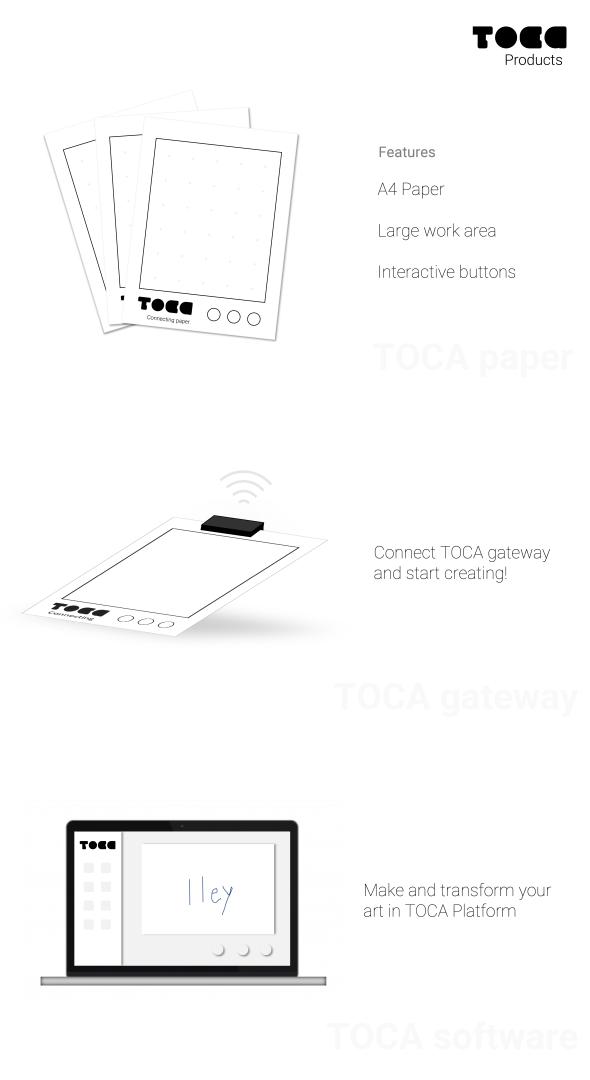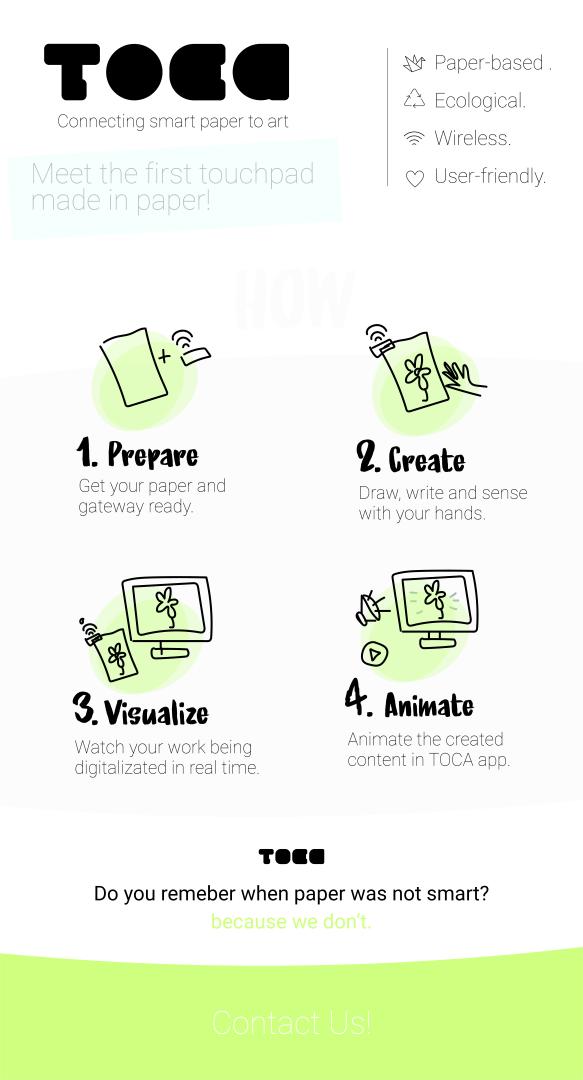TOCA
Basic information
Project Title
Full project title
Category
Project Description
Can you feel the digital texture? Not yet…? Meet TOCA! TOCA is a paper-based interactive (and ecological) surface that can take advantage of both worlds. People of all ages will be able to write and draw on a common paper sheet, while all the content is wirelessly displayed at a computer and/or smartphone in real-time. More, creation will be non-stop since artists can bring their paper drawings to live by adding sounds, colours, and motion on TOCA software, enabling unlimited art possibilities
Project Region
EU Programme or fund
Description of the project
Summary
TOCA is an interactive surface element to be implemented with a visual and sound digital interface. Children or adults can draw different shapes and features using common pencils and pens, to then see and modify these drawings in an electronic device like a computer or smartphone. The user can attribute distinct actions to the drawing, such as sounds, colours and movements, so when they touch the drawing in the physical TOCA surface, they can hear a specific sound, see a colour lighting up, or watch the element move in the computer/smartphone screen.
The idea is based on 3 different elements: i) an interactive surface based on sustainable cellulose materials, which are sensible to pencil or pen drawings, as well as to pressure actions; ii) a gateway where all the fixed electronic elements will be present to connect wirelessly the trackpad to a computer or smartphone; and iii) a digital software present in an electronic device, where the user can interact with the figures drawn on the physical interactive surface.
This interactive surface will be the right element to assist in the digital literacy of children, as well as help people with disabilities to find other ways to communicate. We believe this concept can help children to learn simple programming ideas by connecting the drawings they create into a series of actions in an electronic device. Hence, different logic concepts can be acquired from an early age, to create logical sentences in the correct sequential chain of events. In the case of people with disabilities, this idea can also be important to create a platform to communicate with others, by offering a physical element they can use to express sounds and images.
We believe this project is fully aligned with the New European Bauhaus Prize, as we aim to develop a human-centred paper-like device to enhance creative interactions, while having in mind the current sustainability and digital transformation challenges of the European Union.
Key objectives for sustainability
The current smart living is supported by a competitive global electronics industry that still ignores its environmental impact. Little consideration is given to the beginning of life raw material resources, and their end of life recyclability and reusability. Similarly, manufacturing processes and their impact on the environment, energy consumption and toxicity are not factored in. Nevertheless, there is a growing recognition that the prevailing linear model of “take, make, use and dispose” generates unsustainable waste that could and should be controlled.
In TOCA, we plan to develop the interactive surface with cellulose-based materials, both as substrates and sensing layer, which are natural, abundant and biodegradable, ensuring this way the sustainability of our technological solution. In the interactive surface element, the user will be able to draw, in addition to touch, bend and even fold the pad, so the paper smart surface should be easily replaced, depending on the different types of usage. Apart from being made of sustainable and renewable materials, it will be implemented using low temperature and green chemistry production techniques.
Additionally, our project intends to disrupt the concept of traditional electronics paradigm of “take, make, use and dispose” by aligning the development strategies and objectives with societal needs, EU policies and sustainable development goals (SGD’s). In this context, we envision an eco-designed technology from the get-go to quantify the impact of materials and system choices. Thus, the development of the interactive surface will be grounded on the concepts of circular economy, green and blue economy and sustainability, since all the materials to be used are abundant and recoverable.
Key objectives for aesthetics and quality
In TOCA, we promote direct interaction between a person and a physical object, the writable smart surface, which is then translated into a person to computer interaction. Therefore, we have to take into consideration the aesthetics and design of the human-machine interface, which are grounded on three fundamental aspects: i) design attention to the person’s feelings, emotions, and thoughts; ii) continuous engagement of the person in the experience; and iii) attention to the construction on how the person and the technology interact [Wright, P. et al 2008. Aesthetics and experience-centered design]. Consequently, the physical touchpad here proposed should be simple to use by the target audience, children and people with disabilities, while being a familiar object to the person who uses it. We believe that the implementation of this technology in paper, as the material for the interactive surface, will end up transmitting these feelings of simplicity, approachability and familiarity to the new device. The experience between the person and the device can further be enhanced by the continuous use of the smart surface, as it will become a commonly present object at their desks or playing rooms.
Moreover, the interactive trackpad will also be an extremely thin object, with a thickness of less than five sheets of office paper, contributing to a final slender object, easy to carry and integrate, while it can also be rolled or even folded. Finally, the ultimate design of each TOCA smart surface will depend on the person who will use it, since the fabrication technology is versatile and allows the production of highly customizable devices. The user can also paint different drawings with a variety of colours, since it is also intended for the technology. In this way, these interactive surfaces will be unique for each user, contributing to promote engagement with TOCA smart surface.
Key objectives for inclusion
At the last Porto Social Summit, all partners commit to reduce the number of people at risk of poverty or social exclusion by at least 15 million, with a reduction of at least 5 million children by 2030. This challenging goal can only be addressed if proper education and digital skills are taught to children and those more marginalized, to foster new jobs and maintain livelihoods.
The educative aspect of TOCA can be applied from young ages and throughout different learning stages. As the smart surface is made from paper, children can use it from the moment they can hold a pencil and start drawing, thus easily overcoming the novelty barrier of this device, given the similarity to a normal paper. At early ages, the drawing and attribution of actions in the digital interface can be done with the parents help. Later, children can become autonomous to link colors or sounds to the images they created, through the computer! The interactive surface can be played by distinct types of movements, from direct touching on the figures to finger tracing or even bending and folding of the whole trackpad. This interaction between drawing figures, attribution of actions in the digital interface and physical movements on the interactive surface can be an ideal route to learn computation skills and to create simple and stimulating programming routines in a block-like approach.
The TOCA interactive surface can yet be developed to assist people with disabilities to communicate and demonstrate their artistic expressions. As it does not include any pre-attributed function, the user can create their own buttons with different sizes and colours and control the respective action, depending on the disability and the way the person wants to communicate. Finally, the low cost of the proposed solution also contributes for engagement and inclusion of communities with limited resources, in order to bring them close to art expression, by associating the interactive surface to a digital art form.
Innovative character
Our project is founded on three fundamental innovative ideas. First, we aim to develop cellulose-based materials that are able to sense and discriminate pressure or other mechanical stimuli, in a robust and reproducible way. These pressure sensitive components of the TOCA smart surface are meant to be fully conceived with eco-friendly materials that do not compromise the recyclability and biodegradability of the entire trackpad, while still offering optimized performances and durability.
Secondly, we want to explore a hybrid connection between our paper-based pressure sensitive element and conventional electronics, which will be dedicated to the signal acquisition and transmission to other platforms (computers or smartphones) and displayed in TOCA digital interface. Therefore, TOCA interactive surface would be based on hybrid technology to benefit from the best of both worlds: sustainability and recyclability of the paper elements, which facilitates their replacement in case of intensive use, and high performance of traditional silicon-based electronics. These hybrid-like systems have been more recently explored, and TOCA is the perfect example to show to the general audience how both approaches can work in harmony, towards a more sustainable and greener vision of the future.
Thirdly, the application of this new type of hybrid electronics into an interactive object to express art and communicate is another pioneering aspect of the project. Since we propose to develop a simple paper-based device to be then used to create digital and physical responses, we will expand the ways people can interact with physical objects, in order to have an action in the digital interface. As previously highlighted, for both cases of children education and communication of people with disabilities, TOCA can then be used to establish innovative forms of expression, enhancing not only person-computer interactions but also person-person connections.


